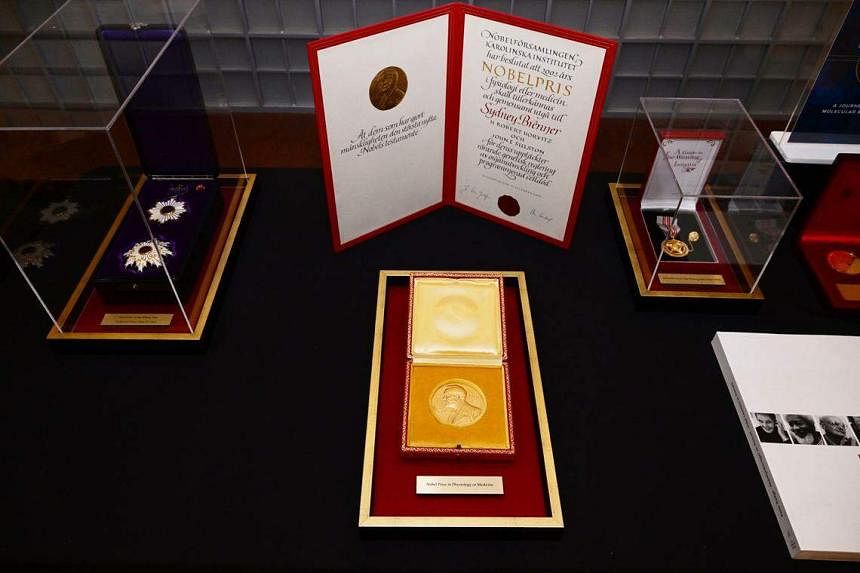SINGAPORE - For his groundbreaking work in molecular biology, which helped shape the field, Dr Sydney Brenner was awarded the Nobel Prize in Physiology or Medicine in 2002.
Soon, the late biologist’s Nobel Prize medal – considered the highest award in science – will be on display in his adopted home of Singapore.
The Viva Foundation for Children with Cancer, a local charity dedicated to research and medical care, will hold the medal here for at least 30 years as part of a collaboration with the Sydney Brenner Charitable Trust in Britain.
Viva Foundation founder and executive chairwoman Jennifer Yeo said the Nobel Prize medal, together with other awards and papers belonging to Dr Brenner, will be placed in a display gallery, and locations are being shortlisted for this purpose.
The medal reflects the “love, devotion and commitment” that Dr Brenner put into his life’s work for the betterment of humanity, Mrs Yeo, the wife of former Cabinet minister George Yeo, told The Straits Times recently.
“We hope to display the medal in a prominent place to inspire other scientists and doctors to rise to the challenge to save more lives and make a positive impact on humanity through their research and clinical treatment,” she said.
Together with the Sydney Brenner Charitable Trust, the foundation is also launching the Sydney Brenner-Viva Research Fellowship, which aims to “inspire young scientists from developing countries whilst equipping them with valuable knowledge and skills training”.
The fellowship is divided into two categories. The Sydney Brenner-Viva Research Fellowship will be awarded annually to exceptional scientists committed to paediatric oncology, with awardees undergoing 12 months of training with mentoring by Professor Rupert Handgretinger from the Children’s University Hospital in Tuebingen, Germany.
Meanwhile, the Sydney Brenner-Viva Travel Fellowship will give recipients the opportunity to participate in the St Jude-Viva Forum in Paediatric Oncology, a tie-up with the St Jude Children’s Research Hospital in the United States.
Research fellows must be from a developing country and be committed to return to their home country after the fellowship to contribute to the cure of childhood cancer, said Mrs Yeo.
Dr Brenner and two colleagues won the Nobel Prize for their study on the roundworm Caenorhabditis elegans that helped identify key genes regulating organ development and programmed cell death.
Born in South Africa to Jewish immigrants, Dr Brenner spent the last few years of his life in Singapore, until his death here at the age of 92 in 2019. He played a pivotal role in shaping the Republic’s life sciences sector, helping to set up the Institute of Molecular and Cell Biology here in 1985.
The Nobel laureate, who became Singapore’s first honorary citizen in 2003, was scientific adviser to the chairman of the Agency for Science, Technology and Research (A*Star) and head of its Molecular Engineering Laboratory until his death.

In 2006, A*Star awarded Dr Brenner the National Science and Technology Medal for his contributions to the development of Singapore’s scientific capability, especially in biomedical sciences.
Dr Brenner’s daughter, Ms Carla Brenner, presented the Nobel Prize medal to Mrs Yeo at a ceremony on Nov 28. His wife, May, died in 2010.
Speaking at the event, Ms Brenner said her father had grown up poor, and had seen people struggle first-hand.
She recalled that while pursuing his medical degree, Dr Brenner was one of only two students who had chosen to do their obstetrics residency at an all-black hospital in South Africa.
“In his last years, my father told me that his explicit wish was to enable young scientists from disadvantaged countries who are without any financial support to flourish,” she said then, adding that he wanted to focus specifically on South Africa and Singapore.
The Nov 28 event, held on the private White Golf Rabbit superyacht in the Marina at Keppel Bay, also saw the Viva Foundation announce the launch of Viva Indonesia, part of its efforts to focus on paediatric oncology in countries with larger child populations.
How much is a Nobel Prize medal worth? Facts about the prestigious award
First awarded in 1901, Nobel Prizes are awarded annually in the fields of physics, chemistry, physiology or medicine, literature, and peace.
Bearing the likeness of Swedish chemist and industrialist Alfred Nobel, the medals are made of 18-carat green gold – a naturally occuring alloy of gold and silver – and plated with 24-carat gold.
Winners also receive prize money, with the amount currently standing at 11 million Swedish kronor (S$1.4 million).
Since 1901, 621 Nobel Prizes have been awarded to 1,000 people and organisations.
Several Nobel Prize medals have been sold for millions of dollars.
Biologists James Watson and Francis Crick, who won the 1962 Nobel Prize in Physiology or Medicine for their discovery of the DNA, had their medals put up for auction.
Dr Crick’s medal was sold for US$2.27 million in 2013, with the proceeds going to the Francis Crick Institute for medical research in London.
Dr Watson decided to sell his medal to make money and rehabilitate his image after he was fired from his position as chancellor at Cold Spring Harbor Laboratory for making racist comments about Africans in 2007.
His medal was auctioned for US$4.75 million the following year, though the buyer, Russian billionaire Alisher Usmanov, later returned the medal to him, stating that it was “unacceptable” that an outstanding scientist had to sell such an award.
Nobel Prize medals are often placed on public display, from where some have been stolen.
The Nobel Prize in Physics medal awarded to US nuclear physicist Ernest Lawrence in 1939 was stolen in 2007 while on display at the Lawrence Hall of Science at the University of California, Berkeley. It was recovered a few days later, and remains on display at the same location.
Author Ernest Hemingway donated the medal for his 1954 Nobel Prize in Literature to the Catholic Church in Cuba, which placed it on display at the National Shrine Basilica of Our Lady of Charity del Cobre in Santiago de Cuba, the country’s second-largest city. It was stolen in 1986, but recovered days later.


